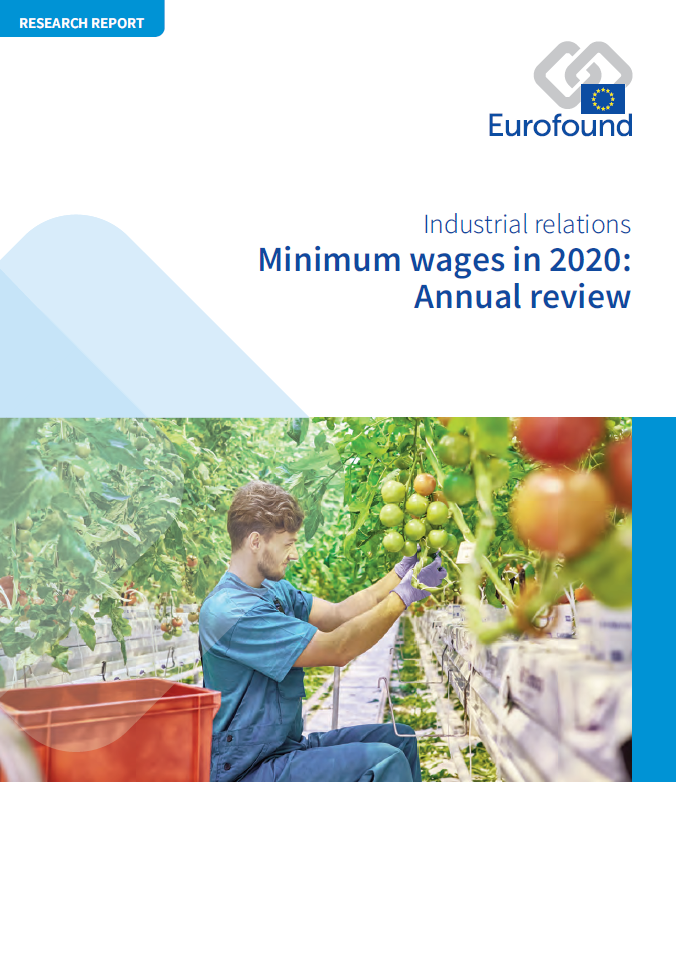
El presente informe, que se inscribe dentro de una serie anual consagrada a los salarios mínimos, resume las principales evoluciones acontecidas durante 2019 y comienzos de 2020 en torno a la iniciativa de la UE en materia de salarios equitativos y sitúa los debates nacionales sobre la fijación de los tipos para 2020 y años posteriores en este contexto. El informe muestra el método seguido para fijar los salarios mínimos y el papel que han jugado los interlocutores sociales. Examina la evolución que han registrado los salarios mínimos regulados y presenta datos relativos a porcentajes de salario mínimo en los convenios colectivos en relación con diez ocupaciones escasamente remuneradas en países sin salarios mínimos regulados. El informe incluye también una sección sobre la dimensión regional de los salarios mínimos y presenta las investigaciones más recientes sobre los efectos que conlleva la evolución de los salarios mínimos en las remuneraciones, el empleo, la pobreza en situación de empleo, los precios y los beneficios.
Key findings
En 2019, numerosos países debatían la posibilidad de un considerable incremento adicional de los salarios mínimos más allá de 2020, en parte en relación con un objetivo relativo, en parte en términos absolutos.
Los salarios mínimos regulados se han vuelto más equitativos en comparación con los salarios de otros trabajadores desde el inicio del milenio (si se comparan los salarios mínimos regulados con los salarios medios del conjunto de los trabajadores).
A pesar de esta tendencia al alza, los salarios mínimos en la mayoría de los países permanecen por debajo del 69% o incluso por debajo del 50% de los salarios medios. Esto es particularmente cierto en el caso de los Estados miembros de Europa central y oriental, cuyos niveles eran relativamente bajos a comienzos del milenio y cuya legislación sobre el salario mínimo sigue fijando objetivos de en torno a un 50% o incluso menos.
En conjunto, 7 de cada 10 de los trabajadores que perciben el salario mínimo comunican como mínimo cierta dificultad para llegar a fin de mes, porcentaje que entre los otros trabajadores no llega a cinco de cada diez; no obstante, estas cifras varían considerablemente entre un país y otro. Por ejemplo, menos del 10% de los trabajadores que perciben el salario mínimo encuentran dificultades o grandes dificultades en Dinamarca, Finlandia, Alemania y Suecia; en comparación, estos porcentajes oscilan entre el 50% y el 60% en Bulgaria, Croacia y Chipre y el 80% en Grecia.
Los gobiernos de toda Europa están adoptando medidas de estabilización de los ingresos para las personas afectadas por la crisis de la COVID-19. Los salarios mínimos pueden jugar un papel en la combinación de medidas orientadas a estabilizar los ingresos y, en consecuencia, la demanda, a fin de contrarrestar una espiral recesiva o de depresión.
Data
Find data on statutory minimum wages in the EU.
- Data: Proportion of minimum wage workers who find it difficult to make ends meet, EU average
- Data: Minimum wage developments in real terms, 15 euro area countries, 2015 price levels
- Data: Proportion of minimum wage workers who find it difficult to make ends meet
- Data: Statutory minimum wages - Minimum wages in the EU in 2020
List of tables
- Table 1: Social partners’ first reactions to the announced initiative on fair wages
- Table 2: Overview of main arguments and proposals concerning an EU minimum wage initiative from social partners
- Table 3: Gross minimum wages, selected EU Member States and the UK, 2019 and 2020
- Table 4: Sub-minimum rates for selected EU Member States and the UK as at 1 January 2020
- Table 5: Further statutory minimum wage rates for private sector workers in selected EU Member States
- Table 6: Number of collective agreements covering low-paying job categories for countries without statutory minimum wages
- Table 7: Minimum wages in collective agreements, applicable in 2019 for selected low-paid jobs
- Table 8: Collective agreement coverage in Finland
- Table 9: Overview of debates during 2019 on aspects of the minimum wage setting processes
- Table 10: Demands for and agreements on targets for future minimum wages to address adequacy in selected EU Member States and the UK
- Table 11: Regional statutory minimum wage rates
- Table 12: Latest minimum wage research in EU Member States and the UK
- Table 13: Overview of recent empirical research in the EU, Norway and the UK on employment impacts of minimum wage increases, 2019
- Table 14: Policies influencing in-work poverty
- Table A1: Network of Eurofound Correspondents – Members participating in the research
List of figures
- Figure 1: Conceptualising adequate minimum wages
- Figure 2: Estimated share of employees earning 90% to 110% of the minimum wage, EU Member States, 2017
- Figure 3: Proportions of female and male employees, EU level, 2017
- Figure 4: Proportion of minimum wage workers per sector, EU level, 2017
- Figure 5: Proportion of minimum wage workers per occupation (top 10), EU level, 2017
- Figure 6: Hourly minimum wages, selected EU Member States, 2020
- Figure 7: Minimum wage developments in real terms, 15 euro area countries, 2015 price levels
- Figure 8: Minimum wage developments in real terms, non-euro area, 2015 price levels
- Figure 9: Impact of purchasing power on the minimum wage value for selected EU Member States and the UK, as at 1 January 2020
- Figure 10: Relative distance between purchasing power of lowest and median minimum wage EU Member States and the UK and highest minimum wage EU Member States and the UK, 2010–2020
- Figure 11: Process for determining minimum wage rates for 2020
- Figure 12: Number of minimum wage rate updates, EU Member States with statutory minimum wages and the UK, since 2010
- Figure 13: Longer-term trend of development of statutory minimum wages relative to median wages of full-time employed workers, selected countries within the EU and the UK, 2000–2018
- Figure 14: Proportion of minimum wage workers who find it difficult to make ends meet, EU average
- Figure 15: Proportion of minimum wage workers who find it difficult to make ends meet
- Figure 16: Making ends meet and minimum wages in relative and absolute terms
- Figure 17: Monthly minimum wage as a proportion of the mean value of average monthly earnings by NUTS1 region, reference year 2016
- Figure 18: Regional variation of relative monthly minimum wages, by NUTS1 region, 2016
- Figure 19: Examples of countries with higher interregional differences in the proportion of minimum wage workers
- Number of pages
-
86
- Reference nº
-
EF20005
- ISBN
-
978-92-897-2068-7
- Catalogue nº
-
TJ-AS-20-001-EN-N
- DOI
-
10.2806/999852
- Permalink
Cite this publication
